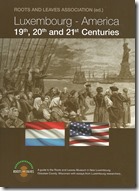 Title: Luxembourg-America: 19th, 20th and 21st Centuries
Title: Luxembourg-America: 19th, 20th and 21st Centuries
Edited by: Brain&More
Format: Hardcover
Published: 2015
My Rating: ![]()
![]()
![]()
The following review first appeared in the Federation of Genealogical Societies FORUM magazine (Summer 2016); reprinted with permission.
Being a descendant of Luxembourg immigrants, I’m always on the lookout for resources to learn more about the history and culture of this small European country. I can tell from my genealogy research that my immigrant ancestors were very proud of their Luxembourg heritage; I guess they took the motto to heart: “Mir wëlle bleiwe wat mir sinn” (“We want to remain what we are”). Having lost the traditions through the generations, I want to connect with those ancestors on a deeper level, and short of traveling to Luxembourg (which I plan to do someday), a book like Luxembourg-America: 19th, 20th and 21st Centuries is a great place to start.
Luxembourg-America has two parts; the first part is almost like a companion to the Roots and Leaves Museum curated by the Luxembourg American Cultural Society in Belgium, Wisconsin, while the second part is a collection of essays about Luxembourg-American culture and heritage. Both parts reflect on the past and bring an understanding about the present.
Having been to the Roots and Leaves Museum, I recognized much of the material presented in the first part of the book. However, there are so many interesting things to take in, you can’t cover every little piece at the museum in a short visit, so this book allowed me to take in everything at my own pace. It’s also something I can refer back to when working on various Luxembourg-related research projects. Like the museum, this part of the book is also arranged by the Luxembourg “roots” and the American “leaves.”
In the “roots” portion, you will learn about Luxembourg’s rich history, as well as its fixture in the world today. Did you know that Luxembourg lost nearly two-thirds of its territory over the centuries, resulting in what is now merely 999 square miles today, the last partition as recently as 1839? Those who have ancestors in this region just might find, for example, that your German family actually came from an area that used to be part of the Luxembourg territory. There are all sorts of facts and figures presented in this section, from the current economic situation and weather climate to the evolution of architecture and everything in-between.
You will then switch to the “leaves” portion and learn about the immigrant experience, from crossing the ocean to daily life in America. It is in this section where you will discover the many Luxembourg settlements throughout the United States. You will also gather an understanding of the culture that the immigrants brought with them to the New World, of which many traditions are still recognized today by descendants. For those who have Luxembourg ancestors, you will gain insight into their lives by reviewing this portion of the book.
The second part of the book is an interesting read. Did you know that the “Father of Science Fiction,” Hugo Gernsback was a Luxembourg immigrant? Born Hugo Gernsbacher, he spent the first 20 years of his life in Luxembourg before setting out for America, where he had success as an inventor, author, and magazine publisher. You can read about his experience as a Luxembourg-American in the essay written by Paul Lesch. The opening essay is an interesting story of Emma (Wolff) Kuhn’s pre- and post-immigration life, written by George Calteux. Other essays include “Luxembourg Culture in America,” “The Creation of a US Military Cemetery Near Hamm,” “Frantz Seimetz, A Luxembourg Painter in the New World,” and “Grand Duchess Charlotte’s ‘Good Will Tours’ Through America.”
The entire book is beautifully illustrated, with gorgeous photographs and accompanying charts and maps. One thing this book could have benefited from is an American editor. The book was compiled, edited, and produced by those based Luxembourg, despite American readers being the target audience. While English is one of many languages in which Luxembourgians are fluent, there are different grammar practices to which American readers are accustom and those ideals and expectations should have been met with much regard. Despite this shortcoming, Luxembourg-America: 19th, 20th and 21st Centuries is still a relevant resource for those with Luxembourg roots and those interested in Western European history.



Share your thoughts...